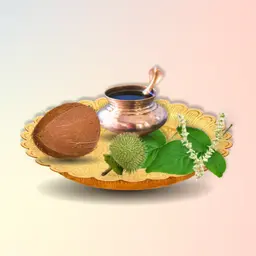
Description
In the vast ocean of Hindu spiritual practices, some rituals shine with immense purity and power. One such sacred tradition is the "Shiva Panchmahabhent" — the offering of five divine items to Lord Shiva. This powerful ritual symbolizes the devotee's complete surrender, love, and devotion to Mahadev, the compassionate destroyer of evil and ignorance.
Especially performed during Shravan Maas (Sawan), Mahashivratri, and Mondays, the Panchmahabhent ritual holds deep significance in temples like Kashi Vishwanath, Omkareshwar Jyotirlinga, Kedarnath, and in homes of countless devotees.
What is Shiva Panchmahabhent?
The word “Panchmahabhent” comes from:
-
Panch = Five
-
Maha = Great
-
Bhent = Offering or gift
So, Shiva Panchmahabhent refers to the five supreme offerings made to Lord Shiva with utmost faith and bhakti.
The Five Offerings of Shiva Panchmahabhent
1. Jal (Water)
Symbolizes purity and surrender. Offering water to the Shiva Linga purifies the soul and cools the fierce energies of Rudra.
Mantra:
"Om Gangadharay Namah"
Benefit: Washes away sins and negativities.
2. Bilva Patra (Bael Leaves)
Represents the Trinetra (three eyes) of Lord Shiva and the Trimurti — Brahma, Vishnu, and Mahesh.
Mantra:
"Om Bilvapatraya Namah"
Benefit: Brings peace, good health, and spiritual growth.
3. Dhatura (Datura Flower/Fruit)
A wild plant with spiritual power. Though poisonous, it is loved by Shiva, the Neelkanth, who consumed poison during Samudra Manthan.
Mantra:
"Om Visha Bhakshanaya Namah"
Benefit: Removes toxic emotions, fear, and obstacles.
4. Bhasma (Sacred Ash)
Represents the reality of life — that all things are temporary and return to dust. Shiva smears Bhasma all over his body.
Mantra:
"Om Bhasma Lingaaya Namah"
Benefit: Destroys ego and connects you with the eternal soul.
5. Sandalwood Paste (Chandan)
Used to anoint the Shivling, it represents cooling energy and divine fragrance.
Mantra:
"Om Chandan Lepitaya Namah"
Benefit: Brings prosperity, divine grace, and inner balance.
How to Perform the Panchmahabhent Ritual
Items Required:
-
Copper or brass pot filled with clean water or Ganga Jal
-
Fresh Bilva leaves
-
Dhatura fruit or flower
-
Vibhuti (Bhasma)
-
Sandalwood paste
Steps:
-
Bathe and wear clean clothes, preferably white.
-
Sit facing east or north.
-
Chant "Om Namah Shivaya" or Mahamrityunjaya Mantra.
-
Offer Jal to the Shivling.
-
Place Bilva Patra with devotion.
-
Offer Dhatura fruit or flower.
-
Apply Bhasma on the Shivling.
-
Gently apply Sandalwood paste.
-
End with aarti and silent prayer.
Best Time to Offer Panchmahabhent
| Occasion | Significance |
|---|---|
| Shravan Maas (July–August) | Most sacred month for Shiva bhakti |
| Every Monday (Somvar) | Shiva's favorite day |
| Mahashivratri | Night of divine union |
| Pradosh Vrat | Powerful bi-monthly Shiva fast |
Spiritual Benefits of Shiva Panchmahabhent
| Offering | Spiritual Effect |
|---|---|
| Jal | Cleansing of karma and emotions |
| Bilva | Mental peace, forgiveness, and blessings |
| Dhatura | Protection from negativity |
| Bhasma | Ego destruction, detachment, and truth |
| Chandan | Attraction of divine energy, prosperity |
Panchmahabhent in Temples
Temples like Omkareshwar Jyotirlinga, Trimbakeshwar, and Kashi Vishwanath conduct daily or special Panchmahabhent rituals during Shravan month, especially on Shravan Somvars. Devotees walk miles in Kanwar Yatras, bringing Ganga Jal to perform these five sacred offerings.


